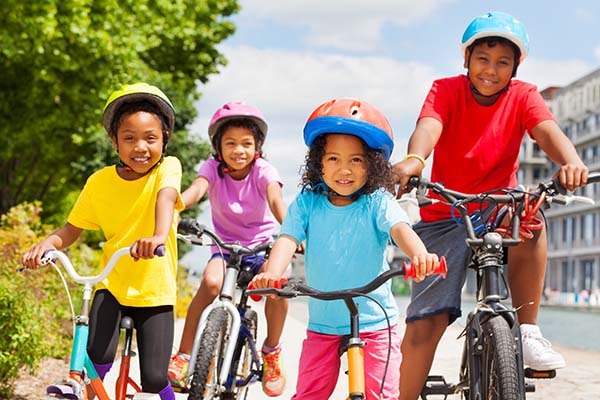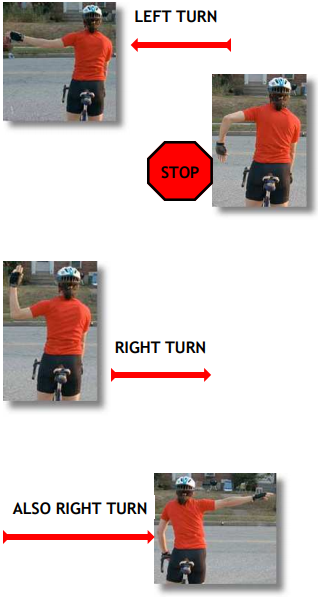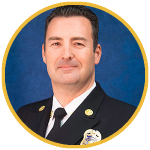It’s the perfect weather outside for a bike ride, but before you head out let’s make sure everyone knows the rules. Why is being bicycle safe so important? In one second an accident could happen. The safer you are the better. Every year 300,000 kids end up in an emergency room because of a bike injury; some even die. Most of these injuries are related to head traumas, that’s why it’s so important to wear a helmet, every time. Helmets reduce your chance of brain injury by 88%!!

Helmet How-To’s
The skull is meant to protect the brain. However, it’s less than 1/4 inch thick and needs added protection during activities where brain injury is possible.
To demonstrate just how fragile the head can be put a raw egg in a sandwich bag. Now from waist height drop it onto a hard flat surface. Of course, the egg will shatter.
Next, get another raw egg and wrap it in paper towels (about 1/4” inch thick) and tape it into a bike helmet, again drop it from waist height onto a hard flat surface. Usually the egg does not break. Now talk about how the helmet did its job by protecting the egg (brain) from a more serious injury.
Discuss with your child the importance of wearing a helmet to protect the brain and skull from similar damage. This activity can also be done with a ripe melon or a light-bulb.
- It should have a sticker from the Consumer Product Safety Commission (CPSC). If it doesn’t ask a grown up for one that does.
- ALWAYS wear your helmet.
- NEVER wear a hat under your helmet; it adjusts the fit, which could make it unsafe.
- Your helmet should fit properly, not to big or to small. If you’re unsure ask for help.
- It should be worn properly too. Level and cover your forehead. Never tip it back so your forehead is showing.
- The straps always need to be fastened. If the straps are lose the helmet could come off when you need it the most. The straps need to be tight enough the helmet cannot wiggle or move.
- Take care of your helmet. If its dropped or damaged it may not protect you as well. If you put your helmet to the test and fall or crash get a new one. Even if it doesn’t look damaged it could be.
Bike Tips
- Get the right size bike. Measure by standing over the top bar so that both feet are flat on the ground. There should be 1-3 inches between you and the top of the bar.
- Make sure the wheels, seat, & handlebars are tightened correctly.
- Check your chain and oil it regularly.
- Check your brakes to ensure proper working order.
- Check your tire pressure.
- Ride with a buddy that way if anything should happen you have someone to help or get help if needed.
- Make sure your parent or guardian knows where you are and what time to expect you back.
Riding in Street Traffic
- Follow the same rules a car would.
- Stop at stop signs, before crossing any street check for traffic both ways, then walk your bike across. Always use a crosswalk if one’s available.
- If you go between cars remember drivers can’t see you.
- Ride in a single file line on the right-hand side of the street, which means riding in the same direction as the cars.
- Use bike lanes or bike routes whenever possible.
- Obey all traffic signals and signs because they apply to bicycles as well as cars.
Beware of parked cars doors can open suddenly. Also keep extra alert of driveways, people can’t always see you when they’re pulling out.
- Wear bright clothes & put reflectors on your bike or helmet.
- Put reflectors on your bike and helmet.
- Ride defensively. Don’t assume drivers see you.
- If your riding at night wear light-colored or reflective clothing.
- Also at night use a white headlight and red reflector for the rear of your bike
- Talk with your parents and know your boundaries. How far you’re allowed to go, on sidewalks or streets, etc.
- Watch for obstacles ahead like puddles, bad road surface, gravel, rocks, curbs, or other kids!
- Children ages 8 years and younger should ride on the right-hand sidewalk until their bicycle riding and traffic skills are developed.
Be predictable. Use hand signals for turns and stops.
Below are pictures of hand signals used by bicyclists to communicate with drivers. These are like turn signals and brake lights for bikers. It helps cars and trucks know what you will do next, so they don’t run into you.


